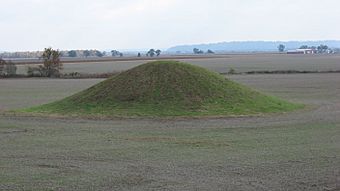Cleiman Mound and Village Site facts for kids
Quick facts for kids |
|
|
Cleiman Mound and Village Site
|
|

Cleiman Mound, with the village site in the background
|
|
| Location | Northeast of the junction of Big Lake and Thomas Town Rds. |
|---|---|
| Nearest city | Gorham, Illinois |
| Area | 129 acres (52 ha) |
| NRHP reference No. | 77000487 |
| Added to NRHP | October 18, 1977 |
The Cleiman Mound and Village Site is a very old and important place in Jackson County, Illinois. It's located near the Mississippi River. This site has an ancient burial mound and the remains of an old village. Many different groups of people lived here long ago.
People started living at this site before 400 B.C. and stayed until about 1300 A.D. This means it was used for over 1700 years!
Contents
Exploring the Cleiman Mound Site
The Cleiman Mound and Village Site tells us a lot about ancient people. It shows how different cultures lived in this area. This site is like a giant history book buried in the ground.
Who Lived Here?
Over many centuries, different groups of people called this place home. They lived here during three main time periods:
- The Archaic period
- The Woodland period
- The Mississippian period
Each group left behind clues about their lives. These clues help archaeologists understand their daily routines.
The Mysterious Mound
The large mound at the site was built during the Middle Woodland Period. It was created by people known as the Hopewellian culture. These people were known for building large earthworks.
This mound is very special. It is likely the only Hopewell mound found in the Mississippi Valley in Southern Illinois. Mounds like this were often used for burials or important ceremonies.
Why is This Site Important?
The Cleiman Mound and Village Site helps us learn about early American history. It shows how people lived, hunted, and built communities. Studying these sites helps us understand our past.
The site was officially recognized for its importance. It was added to the National Register of Historic Places on October 18, 1977. This means it is a protected historical treasure.



